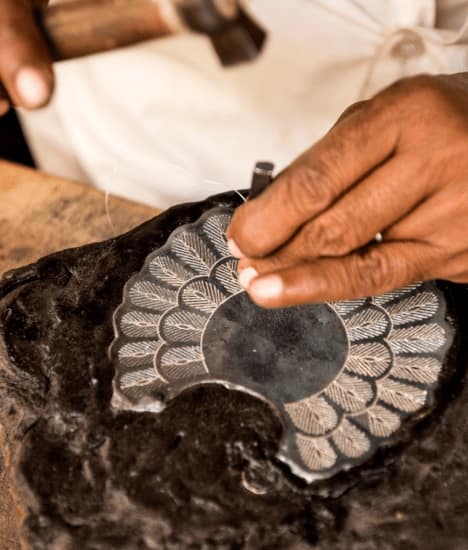Bidri: A Piece Of Heritage Craftsmanship In Karnataka
This inlay metal craft from Karnataka, which is believed to have originated in Persia and thrived in India, tells the tale of a legacy that spans hundreds of years
India has always been home to a rich artistic legacy and craftsmanship. Often each kingdom promoted and supported a regional art or craft that was practised by communities in the region. One such metalwork craft that thrived in the Deccan region for hundreds of years came from the small town of Bidar, borrowing the name of Bidri.
 A Bidri craftsman engraves a traditional design on a vase. Picture: Shutterstock/Akella Srinivas Ramalingaswami
A Bidri craftsman engraves a traditional design on a vase. Picture: Shutterstock/Akella Srinivas Ramalingaswami
Origin of Bidri Metalwork
Some sources say that the craft was brought to India a millennium ago by Khaja Mohiuddin Chishti, and his followers. For others, the roots of Bidri metal work in India can be traced back to the 14th century, in the town of Bidar in Karnataka and its origins are often intertwined with tales of the Bahmani Sultanate, where skilled artisans merged local craftsmanship with Persian influences to create a unique and exquisite art form. However, some historians believe that the art originated in the 16th century as a byproduct of Indo-Islamic culture that prevailed in the region during the 16-17th century. Over time, the craft form changed its techniques and designs under the patronage of different rulers.
 A Bidri craftsman inlays fine silver wire in to the grooves of a paper weight, in Bidar. Picture: Shutterstock/Akella Srinivas Ramalingaswami
A Bidri craftsman inlays fine silver wire in to the grooves of a paper weight, in Bidar. Picture: Shutterstock/Akella Srinivas Ramalingaswami
The Process of making Bidri Artefacts
At the heart of Bidri work lies its unique composition – a zinc-copper alloy that acquires its distinctive black colour through a process of oxidation. Traditionally, the craftsmen of Bidar use the soil that has been taken from grounds of a 15th century fort in Bidar, which has potassium nitrate, mixing it with ammonium chloride and water. This paste is rubbed onto the heated brass surface, resulting in a visually striking black background. Skilled craftsmen then chisel intricate patterns onto the surface, creating a contrast with the dark base. This is how the finished product bears a blackened appearance with silver inlay work.
 Bidri is believed to have originated in Persia. Picture: Shutterstock/Akella Srinivas Ramalingaswami
Bidri is believed to have originated in Persia. Picture: Shutterstock/Akella Srinivas Ramalingaswami
Bidri metal work, classified into four types – Teh nashin, Aftabi, Tarkashi, Zar buland – often draws inspiration from nature, folklore, and geometric patterns. Designs frequently feature floral motifs, intertwining vines, peacocks, and other animals. Over the years, products both utilitarian and decorative, such as hookah, vase, boxes, plates and more were imprinted with floral and geometric designs by local artisans.
 Bidri craft today has centres in Bidar and Hyderabad. Picture: Shutterstock/Akella Srinivas Ramalingaswami
Bidri craft today has centres in Bidar and Hyderabad. Picture: Shutterstock/Akella Srinivas Ramalingaswami
The Present
While you can get your hands on Bidri products in Bidar and Hyderabad, the Salar Jung Museum in Hyderabad is the perfect place to learn more about its history. It has on display a wide collection of Bidri craftwork, including 600 pieces from 16th to 20th century. Renowned for its distinctive dark alloy and intricate silver inlay patterns, Bidri metal work today has centres in these two cities. In recent years, artisans have adapted techniques to create modern pieces that blend traditional charm with a contemporary aesthetic. The craft has also found its way into jewellery, home decor, and even fashion accessories, and was also granted the Geographical Indication (GI) registration in order to promote its cultural heritage.







 Bidriware is a GI-tagged metal craftform from Karnataka. Picture: Shutterstock/Akella Srinivas Ramalingaswami
Bidriware is a GI-tagged metal craftform from Karnataka. Picture: Shutterstock/Akella Srinivas Ramalingaswami



